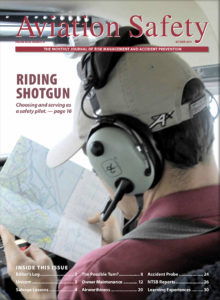- Editor's Log
- Unicom
- Seeing, Avoiding
- Two Engine Failures
- Pitot/Static Problems
- Propeller Theory
- Giving It The Slip
- Accident Probe
- NTSB Reports
- Learning Experiences
To continue reading this article or issue you must be a paid subscriber. Sign in
Subscribe to Aviation Safety
Start a subscription to Aviation Safety for just $18. And access all of our online content - over 5,000 articles - free of charge.
Subscribe today and save 39%. It's like getting 2 months FREE!


Hi,
From CrossFire magneto
i would like to do advertisment, how can i apply?
Thank you very much,
November Aviation Safety, Seeing and Avoiding. My perspective.
Over the years my experiences with “See and Avoid” scare the crap out of me. Such as: Being down wind while being cut off by an over airport mid-field entry, Entering the pattern with a non communicating aircraft within the pattern, or being dumped from an IFR environment; too high and close to the pattern or wrong side of the airport pattern entry without traffic knowledge.
Any recent example of mid air pattern accidents is painful to report and analyze. ( My deepest sympathies to the families ). James R Warmkessel makes his attempt to critique elements of see and avoid and what the pilots may be doing.
The elements of his article include, * See and Avoid visual limitations imposed by the aircraft structure. (My experience also). * Limited Pilot experience; eg. learning the aircraft and in the pattern. * Mature Pilot experience with complete familiarity of the pattern and flying process. * And Communication.
A pilot ‘Being in the Pattern’ is a different thought process than ‘Entering the Pattern’ from beyond.
Historically we train Pilots to Aviate, Navigate, and Communicate when faced with Problems. (A Safety Risk: called “Distraction”). Communication is last since the pilot must judge each issue and resolve the distraction before he, she Communicates intentions. In the pattern what we communicate based on our experiences may be obvious or ignorance. I suggest that Communication should come first in the airport environment. Communication leads to an understanding of the environment then defines and alters navigate and aviate to a pattern position.
Most importantly, does what we communicate reflect the intent of our actions. If Student 1 is reporting a pattern position and Twin 2 is reporting a position, then more blah blah blah, but without expressing actual intention? This is Talk, Not Communication. In another Aviation Safety article about Risk Management was a discussion of COMPLACENCY. Meaning “I know my intention without consideration to consequences.”
The airport is about Entering the standard pattern, Flying the standard pattern, and Landing. Everything else is a Non Standard Procedure. I Recommend that we communicate Our Intent to fly the pattern.